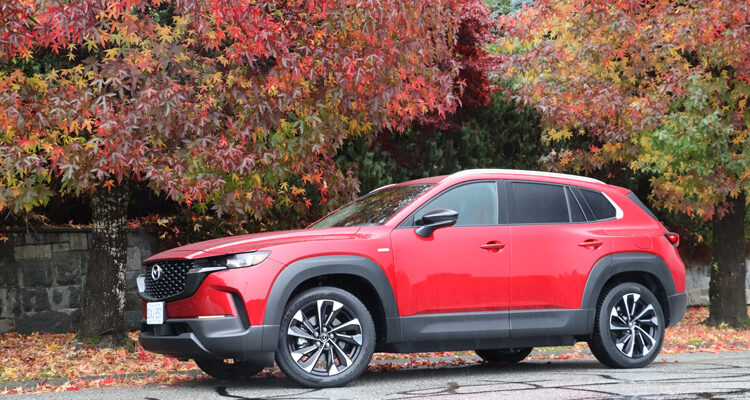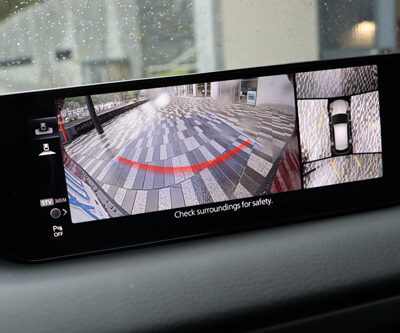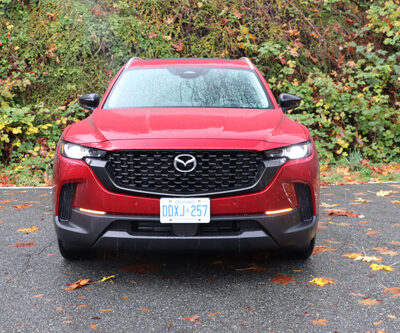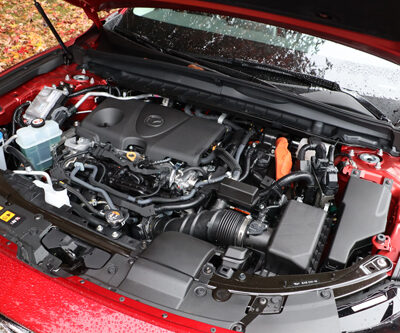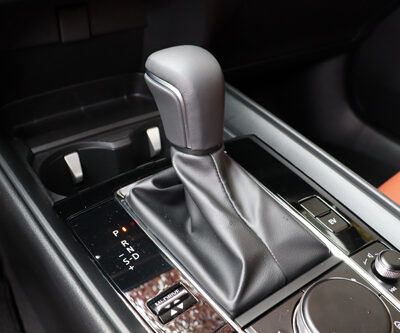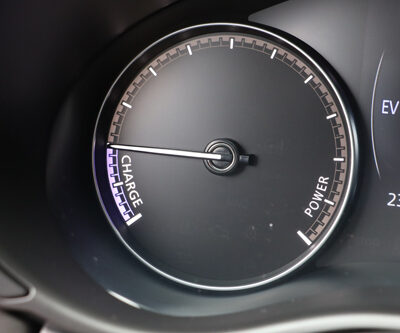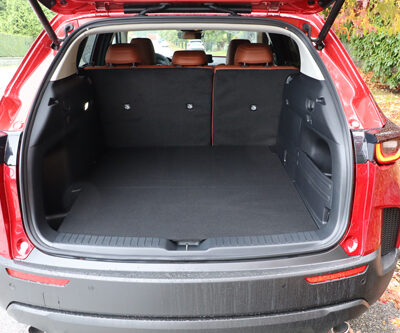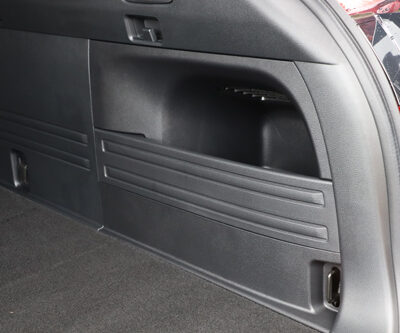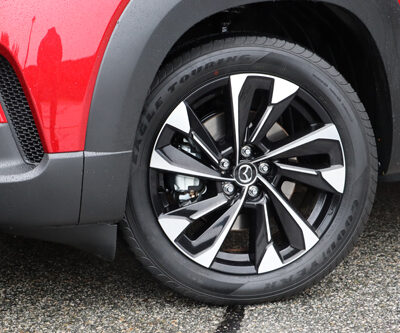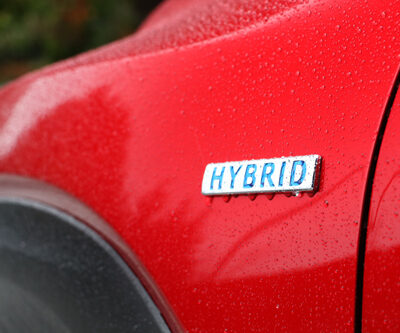Vancouver, BC — So you’re Mazda. You’re a small-ish car company in the grand scheme of things that makes fantastic-looking vehicles with great handling characteristics and top-drawer fit and finish inside. You have a good AWD platform and you have some good engines as well, including a plug-in hybrid (PHEV) that can drive for about 40 km on EV power alone – all good.
But there’s a problem.

You have the PHEV – available in both the CX-70 and CX-90 – but it’s expensive and only available in your largest vehicles. Those same vehicles get a mild-hybrid choice as well, by that we mean a gas powertrain with 48V alternator that can provide boost on acceleration or relief on the gas engine during cruising. What you don’t have is an offering in the middle ground: the oh-so popular hybrid compact crossover. That’s “HEV” as opposed to “PHEV”; a small gas engine paired with a small EV motor and battery. You’re Mazda, and your HEV powertrain is a couple of years away and the time is now; so what to do?
Well, since you’re Mazda, you go back to a group you’ve been bedfellows with before, and that has some of the best HEV tech on the market today: Toyota.
The two groups have paired together on models a number of times previous, but you’ll probably best remember the Mazda2 / Yaris sedan mashup of the early 2010s. In truth, there’s been a few Mazda x Toyota projects through the years so the move on Mazda’s part isn’t such a surprise.

Essentially what they’ve done is lifted the entire hybrid powertrain from the popular RAV4 crossover and wedged it into the CX-50 crossover. That’s right; from transmission to engine, this Mazda is a Toyota.
Power comes courtesy of a 2.5-litre four-cylinder plus EV motors, good for 219 horsepower and 163 pound-feet of torque but more importantly, a 6.2L/100 km combined fuel rating. Power-wise, those figures have the CX-50 Hybrid smack dab in the middle of the CX-50 line-up, between the 2.5L turbocharged four-cylinder and the non-turbo variant. Both of those, however, get traditional automatic gearboxes while the Hybrid gets a continuously-variable automatic, or CVT.
Looks-wise, you have to really know your CX-50s if you were to be able to spot the differences between the Hybrid and the other models; the Hybrid’s wheel diameter maxes out at 19 inches (other models get 20s) and there’s thicker plastic cladding ‘round the wheel wells and rocker panels – that’s it. The reason for the added plastic is not about protecting bits of the hybrid powertrain but rather a purely aesthetic exercise. The Hybrid is a little taller – we’re talking millimetres, here — so in order to accommodate the added running gear without compromising on interior space or ride height, Mazda says the added plastic helps disguise the taller stance. We’ll have to take their word for it because it’s hard to tell the difference; perhaps parking a Hybrid next to a standard model would reveal more.

It should come as little surprise that the Hybrid’s interior is a spitting image of the standard car. That’s actually a good thing as that means the driver’s seating position is right on and the materials and fit and finish are of the highest order. Since Mazda has no luxury division, it has to drop just a little extra je ne sais quoi inside. On the GT model we sampled, that came in the form of two-tone real leather seating, a leather dash with contrast colour stitching and leather-wrapped heated steering wheel. There’s also heated and cooled front seats, heated rear seats, Bose audio (not bad, but not the best, either) and wireless Apple CarPlay and Android Auto. Which, it has to be said, proved to be a challenge to set up but eventually we did get a reliable connection. Like the exterior differences from the CX-50, the interior changed are subtle: there’s a charge/power gauge instead of a tach, a longer gearlever and in the cargo area, a cover across the wall-mounted cubby which Mazda says protects vital aspects of the hybrid system.
Even with that, the Hybrid sacrifices nothing to the gas models cargo-wise; it gets a deeper rear cargo area than the CX-5 and is wider overall; that’s good for interior room especially in terms of back seat space although you do have to sacrifice the CX-5’s clever 40/20/40 split rear seat in favour of a more traditional 60/40 split. So you can still get longer items through, but not without sacrificing one of outboard seats.
We mentioned at the outset of this tale that Mazda has a penchant for building some great-handling cars and also has a pretty good engine line-up. The question is, then, how does the Toyota hybrid powertrain fit that mold?
Thanks to the CVT ‘box, the power delivery is smooth but as is the case with so many of these, they just aren’t the most involved of powertrains. There’s just something about the feeling of cogs being swapped that adds to the thrill of any drive. So you don’t get that here but at least you don’t get that telltale CVT whine as you set off, unless you’re really pushing it, say, on a freeway entrance. It’s a smooth operator, though, and moving through town is made all that much more enjoyable as a result.

What the CX-50 Hybrid does keep though is a composed ride over a variety of bumps. It’s a little firmer than the segment average but that’s kind of what Mazda is about, as it translates to some properly athletic handling. The dampers settings are highlighted by some great rebound control and body roll is minimized – we have the lower, wider stance to thank for that.
The steering is what really, well, drives the whole experience home. Mazda’s penchant for delivering well-weighted and responsive steering has made it to the CX-50 Hybrid without missing a beat; the wheel diameter is perfect in size and even though it’s a very responsive rack, it’s not nervous because there’s enough steering weight there that you’re not having to constantly adjust to stay in your lane on the highway, for example. More than that, the steering column is so robust that even larger road imperfections and surface obstacles cause little to no shudder through the wheel of any kind. The steering is one’s best connection to the car and the road below so it behooves an OEM to get it right and by golly, has Mazda ever gotten it right here.
It’s a good package, the CX-50 Hybrid. Yes; you do have to deal with that whiny CVT and you do feel the added weight from the hybrid system but the rest of the package – the handling, the styling, interior fit and finish – is Mazda through and through, and that’s the key.



